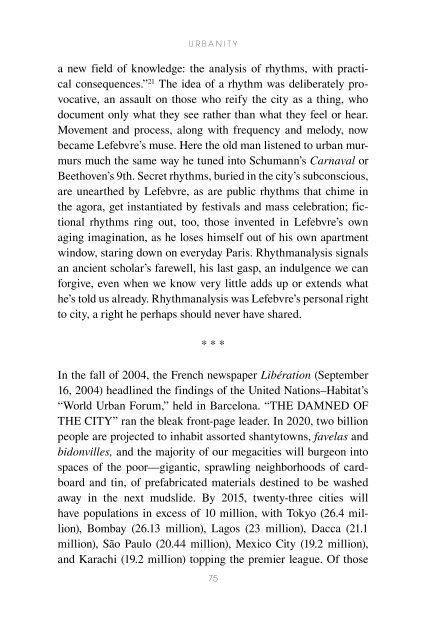Henri Lefebvre: A Critical Introduction - autonomous learning
Henri Lefebvre: A Critical Introduction - autonomous learning
Henri Lefebvre: A Critical Introduction - autonomous learning
You also want an ePaper? Increase the reach of your titles
YUMPU automatically turns print PDFs into web optimized ePapers that Google loves.
U r b a n i t y<br />
a new field of knowledge: the analysis of rhythms, with practical<br />
consequences.” 21 The idea of a rhythm was deliberately provocative,<br />
an assault on those who reify the city as a thing, who<br />
document only what they see rather than what they feel or hear.<br />
Movement and process, along with frequency and melody, now<br />
became <strong>Lefebvre</strong>’s muse. Here the old man listened to urban murmurs<br />
much the same way he tuned into Schumann’s Carnaval or<br />
Beethoven’s 9th. Secret rhythms, buried in the city’s subconscious,<br />
are unearthed by <strong>Lefebvre</strong>, as are public rhythms that chime in<br />
the agora, get instantiated by festivals and mass celebration; fictional<br />
rhythms ring out, too, those invented in <strong>Lefebvre</strong>’s own<br />
aging imagination, as he loses himself out of his own apartment<br />
window, staring down on everyday Paris. Rhythmanalysis signals<br />
an ancient scholar’s farewell, his last gasp, an indulgence we can<br />
forgive, even when we know very little adds up or extends what<br />
he’s told us already. Rhythmanalysis was <strong>Lefebvre</strong>’s personal right<br />
to city, a right he perhaps should never have shared.<br />
* * *<br />
In the fall of 2004, the French newspaper Libération (September<br />
16, 2004) headlined the findings of the United Nations–Habitat’s<br />
“World Urban Forum,” held in Barcelona. “THE DAMNED OF<br />
THE CITY” ran the bleak front-page leader. In 2020, two billion<br />
people are projected to inhabit assorted shantytowns, favelas and<br />
bidonvilles, and the majority of our megacities will burgeon into<br />
spaces of the poor—gigantic, sprawling neighborhoods of cardboard<br />
and tin, of prefabricated materials destined to be washed<br />
away in the next mudslide. By 2015, twenty-three cities will<br />
have populations in excess of 10 million, with Tokyo (26.4 million),<br />
Bombay (26.13 million), Lagos (23 million), Dacca (21.1<br />
million), São Paulo (20.44 million), Mexico City (19.2 million),<br />
and Karachi (19.2 million) topping the premier league. Of those<br />
75
















